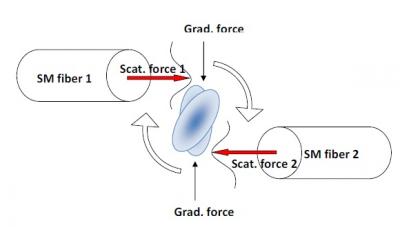Dec 4 2012
Harnessing laser light's ability to gently push and pull microscopic particles, researchers have created the fiber-optic equivalent of the world's smallest wrench. This virtual tool can precisely twist and turn the tiniest of particles, from living cells and DNA to microscopic motors and dynamos used in biological and physical research.
 This shows the principle of fiber-optic spanner comprised of transversely offset fibers. Credit: Optics Letters
This shows the principle of fiber-optic spanner comprised of transversely offset fibers. Credit: Optics Letters
This new twist on controlling the incredibly small, developed by physicists at The University of Texas at Arlington, will give scientists the ability to skillfully manipulate single cells for cancer research, twist and untwist individual strands of DNA, and perform many other functions where microscopic precision is essential. The authors describe their new technique, which they dub a fiber-optic spanner (the British term for a wrench), in a paper published today in the Optical Society's (OSA) journal Optics Letters.
The innovation that distinguishes this technique from other optical tools is that it can, for the first time, spin or twist microscale objects in any direction and along any axis without moving any optical component. It's able to do this because it uses flexible optical fibers rather than stationary lasers to do the work. This has the added benefit that the optical fibers can be positioned inside the human body, where they can manipulate and help study specific cells or potentially guide neurons in the spinal cord.
Rather than an actual physical device that wraps around a cell or other microscopic particle to apply rotational force, or torque, the fiber-optic spanner is created when two beams of laser light – emitted by a pair of optical fibers – strike opposite sides of the microscopic object.
Individual photons impart a virtually imperceptible bit of force when they strike an object, but an intense beam of laser light can create just enough power to gently rotate microscopic particles. "When photons of light strike and then get reflected back from an object, they give it a small push from an effect called scattering forces," explains Samarendra Mohanty, assistant professor of physics at The University of Texas at Arlington and lead author of the study. This technique is already used to perform optical "tweezing," which can move an object forward and backward along a straight line. "Optical tweezing is useful for biomedical and microfluidic research," said Mohanty. "But it lacks the control and versatility of our fiber optic spanner, especially when it comes to working deep inside."
In the team's new optical spanner, the optical fibers use laser beams to first trap an object and then hold it in place. By slightly offsetting the optical fibers, the beams are able to impart a small twisting force, which causes the object to rotate in place. Depending on the positioning of the fibers, it is possible to create rotation along any axis and in any direction. This greatly enhances researchers' ability to study and image cells and groups of cells for biological research and medical analysis.
In their research, Mohanty and graduate student Bryan Black used their new technique to rotate and shift human smooth muscle cells without damaging them. Demonstrating that the technique may have both clinical and laboratory uses.
For example, the spanner could rotate cells in a microfluidic analysis, image them with tomography, and then move them aside to allow the analysis of subsequent cells in the flow.
The technique could also be used to rotate single cells to determine by their spin if they are normal or cancerous. It could also help examine embryos to aid in in-vitro fertilization. It could mix or pump the fluids in lab-on-a-chip devices, or move and rotate micro-spheres attached to the opposite ends of a DNA strand to stretch and uncoil the molecule, allowing it to be sequenced more efficiently. In a follow-up paper to be published in Applied Physics Letters, Mohanty describes how this method can be used to rotate and fluorescently scan an object, which would reveal details about its chemical properties.
Non-medical macroscopic uses for the tool are also possible. "I envision applications in the direct conversion of solar energy to mechanical energy, rotating large, macroscopic objects using this technique," Mohanty says. This would "simulate an environment in which photons radiated from the Sun could propel the reflective motors in solar sails, a promising future technology for deep-space travel."